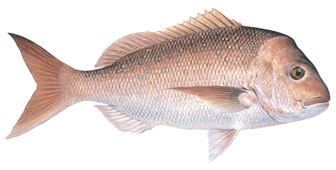
Pink snapper (Chrysophrys auratus) is a valuable commercial species and is prized by recreational fishers for its delicious taste. Despite its name, it actually belongs to the sea bream family (Sparidae). It’s related to species such as black bream and tarwhine rather than species in the true snapper family (the Lutjanidae).
The top half of its body and its top, tail and side fins are pink. The bottom fins range from pale pink to creamy white. It has blue spots on the upper body.
In several ‘bioregions’ (biological regions), pink snapper is an ‘indicator species’ meaning its stock status is used to indicate the status of other demersal (bottom-dwelling) species.
Pink snapper grow to more than one metre and 10 kg. They grow relatively slowly, so stocks (populations) take a long time to recover from overfishing.
Pink snapper form spawning ‘aggregations’ (groups), which are often found in the same few locations each year. During spawning eggs and sperm are released into the water and fertilisation takes place externally.
Distribution and habitat
Pink snapper are found in coastal waters off New Zealand and Australia.
In Western Australia, they are found in warm temperate to sub-tropical waters from north of Karratha southwards to the Great Australian Bight.
Pink snapper typically live in waters 20-250 m deep. They are demersal (bottom-dwelling) but also spend some of their lives in the mid to upper water levels.
Adults live around reefs but also over muddy and sandy bottoms along the continental shelf and in more protected waters when spawning. Juveniles are common in bays, inlets and estuaries, which provide important nursery areas.
Tagging projects have shown that while some pink snapper can move hundreds of kilometres to find food or spawn, most show more restricted movement patterns.
For example, pink snapper tagged in oceanic waters outside Shark Bay were mostly captured within 20 km of their release point. There is evidence that adults that aggregate to spawn in certain areas, for example, Cockburn Sound, return to that location each year.
Lifecycle
Pink snapper can live for more than 40 years.
Those in southern areas, such as the waters near Perth, reach greater maximum lengths and ages than those further north.
Near Carnarvon, female snapper mature at about 380 mm and four years of age, but near Perth, they don’t mature until about 580 mm and six years of age.
Spawning peaks between May and September in Carnarvon and October to December in Perth.
Adults aggregate to spawn in Cockburn Sound off Perth and about 1000 km to the north near islands offshore from Carnarvon. However, mature and spawning individuals are also found along the coast between those two locations.
The variations in spawning time indicate that water temperature is important for successful spawning and survival of larvae. Peak spawning in Cockburn Sound has been found to occur when water temperatures are about 19 to 20°C.
Eggs and larvae produced at the two aggregation sites are kept there by localised currents. This helps keep the offspring in a protected environment, which they use as a nursery. The juveniles in Cockburn Sound usually leave after about 14 months and move into deeper waters, then possibly along the west coast.
Diet
Pink snapper feed on small fish, crustaceans, worms, molluscs, jellyfish, echinoderms (such as sea urchins) and algae.
Predators
Species such as large cods, dolphins and sharks prey on pink snapper.
Illustration © R. Swainston/www.anima.net.au